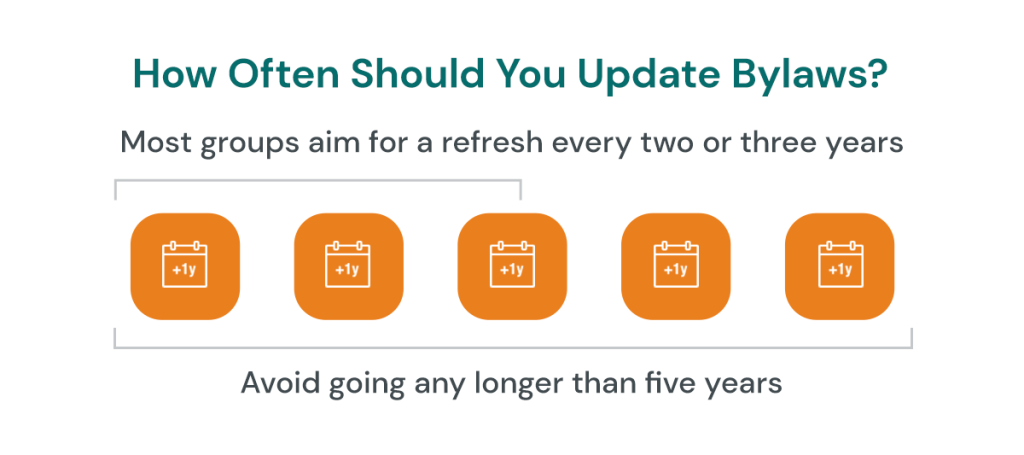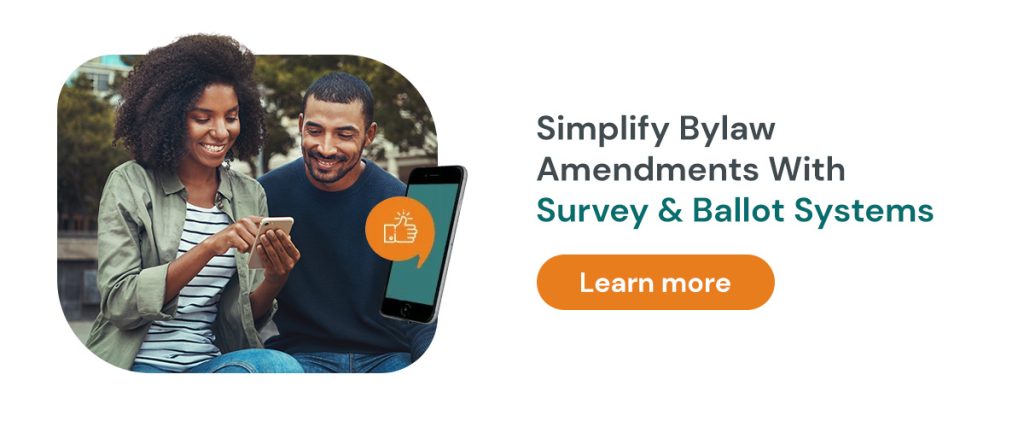How to Change and Amend Your Organization’s Bylaws
Table of contents
What Are Bylaws?
Your bylaws are the set of rules that govern your organization. Your staff and board of directors likely know them backward and forward. But how does your organization adjust its bylaws when it’s time for a change?
For Nadine Merker, director of member and volunteer engagement at the American Association of Diabetes Educators, the process of changing bylaws ultimately falls under the authority of the board.
“If the governing body finds that the bylaws are in conflict with the strategic vision, direction, mission or operation of the organization, a motion is made to change them,” Merker said.
Once the idea is in motion, the AADE board of directors discusses and approves it. Then, members get to vote on the proposed changes. This process can vary depending on the organization and its bylaws.
Merker explained that bylaws define how members should vote, and that it’s essential to follow the process to the letter. That’s why organization leaders must know their bylaws completely.
While every organization has different policies and procedures, we’ll take a look at the general process, some tips for changing nonprofit bylaws, and an FAQ on all things bylaws.
How to Amend Bylaws
To amend bylaws you should:
- Review and Propose
- Amend
- Vote
Whether you work with a union, a homeowners association, a cooperative or another member-based organization, you likely have a specific process for amending bylaws. It can vary from group to group, but here is a general guide on proposing changes to your organization’s bylaws.

1. Review and Propose
If your board or governing body finds the need to expand upon, update, delete or modify your bylaws, be sure to follow the rules for making an amendment.
If necessary, your bylaws should also define how to vote on a proposed amendment.
In the proposal stage, it is typical for the board to gather input on modifying the proposal as necessary.
2. Amend
If you need to change your bylaws, send a document communicating the changes to members. Again, following the defined process on voting is essential. Follow the appropriate steps to ensure your organizationis making changes correctly.
3. Vote
Your organization’s bylaws provide a precise framework on how bylaw changes are to take place — strictly adhere to those rules! You must notify members that a vote is happening and what the proposed changes will be, so be sure to give appropriate notice. Provide your members with a clear and convenient way to cast their vote that follows your procedures.
FAQs on Bylaws
If you still have some questions about bylaws, you’re not alone. Bylaws are a unique concept that many people outside community groups or nonprofit organizations have little experience with. Whether you want a refresher or more information on how bylaws work, here are a few common questions and answers.
Why Are Bylaws Necessary?
Bylaws are the formal rules that govern your organization. They outline topics like your group’s purpose, membership requirements, and guidelines for conducting meetings and voting. If there’s ever a question on how to do something correctly, you will typically look to the bylaws.
One distinct feature of bylaws is that they have legal standing. Violating your bylaws could cause the organization to face court challenges. That’s why we always suggest having an attorney skilled in this area to help draft bylaws. Some organizations, like nonprofits, must also file their bylaws with the state.
Can Bylaws Change?
As we discussed in the last section, you can amend your bylaws. It isn’t as straightforward as updating a document, but you can make changes if you go through the correct channels and obtain the necessary votes from your members. After all, they agreed to a specific set of bylaws when they joined, so changing those rules requires their input.
How Often Should You Update Bylaws?
The answer to this question depends on your organization. Most groups aim for a refresh every two or three years and avoid going any longer than five years.

Times change, and so do your members. Updating your bylaws allows you to keep them current. For example, social media platforms have changed how many board members get elected. If you haven’t discussed how candidates will conduct themselves online, you might be overlooking some crucial elements. You can also watch our video, “Signs Your Cooperative Bylaws Need to Change” for more insight.
How Do You Write Bylaws?
Writing bylaws can be a highly involved process. If you’re starting from scratch, this guide from the University of Kansas can walk you through the specifics. You’ll need to collect some examples, decide who will approve the bylaws, write your drafts, and get them approved.
If you’re only updating your bylaws, try to follow similar language to the rest of the document. Keep a record of the original amendment from before you changed it, as well as who proposed the change and why. If your bylaw involves some legalese, consider creating a plain-language summary when you have members vote to prevent misunderstandings.
6 Tips for Amending Bylaws
Remember these tips as you work on amending your bylaws.
1. Learn How State Laws Affect Your Bylaws
Your state’s statutes supersede your organization’s bylaws. It may seem obvious, but it never hurts to double-check that the bylaws you’re changing do not include practices prohibited by law. “Default” rules outlined in your state’s laws might even override your organization’s bylaws. We understand it can be confusing, so it’s helpful to consult a professional to ensure full compliance with the law.
Before significantly changing your organization or nonprofit’s bylaws, consider consulting a qualified attorney early in your process and check in periodically throughout the amending and election period. A legal adviser will ensure your organization’s new bylaws are consistent and written to the letter of the law.
2. Ensure Your Bylaw Committee Represents Your Organization
Is your bylaw committee an accurate cross-section of your organization or nonprofit’s membership? Does your board and bylaw committee reflect your organizational diversity? If not, you could see large-scale opposition to the approval of your bylaw proposals.
Ensuring a diverse representation of membership helps prevent an “us-versus-them” mentality between members and the board. Remember to include a range of ages and generations in your elections and clarify current voting trends and technologies for your committee.
3. Use the Right Tools
As challenging as amending bylaws and initiating their elections can be, the right technology can make a world of difference. Our real-time voting software is an intuitive platform that empowers members to make their voices heard. This solution makes it quick and painless to amend bylaws while potentially cutting costs for your organization and following bylaw voting system requirements.
4. Regularly Amend and Update Your Bylaws
Antiquated, unnecessary bylaws can create confusion, high costs, and low voter response rates in member elections, usually due to the lack of modern and easy voting options. Make it a point to regularly look into amending or replacing bylaws to keep your organization from falling behind, which may require a complete overhaul instead of just fine-tuning.
5. Pay Attention to the Approval Process
Amending bylaws will almost always require member approval for organizations with voting members. Be sure to follow any established timelines to submit proposed amendments — failure to do so can cause unnecessary and frustrating delays.
6. Don’t Make Amending Your Bylaws Too Difficult
Set your organization or nonprofit up for success. Make the process easy to understand so your organization will receive amendment proposals, and focus on the ability to adapt over time with an approved voting system for bylaws.
Your organization’s bylaws help govern and run your member organization. As your organization changes, your bylaws should remain up to date and reflect current circumstances.
Simplify Bylaw Amendments With Survey & Ballot Systems
Some groups shy away from amendment updates because organizing a large vote can be daunting. With the right tools, you can make voting as easy as clicking a link in an email or mailing a ballot. Other simple voting methods include live voting during meetings or a hybrid approach. At Survey & Ballot Systems, we help organizations access simple voting solutions for bylaw updates and much more.
We offer a wide range of online, onsite, paper-based and combination voting tools, along with fully managed services to oversee the entire process. Contact us today to learn more about what we do or ask questions about amending your bylaws — our knowledgeable team is here to help!
Next post: How to Find Volunteers for Your Next Virtual Even


